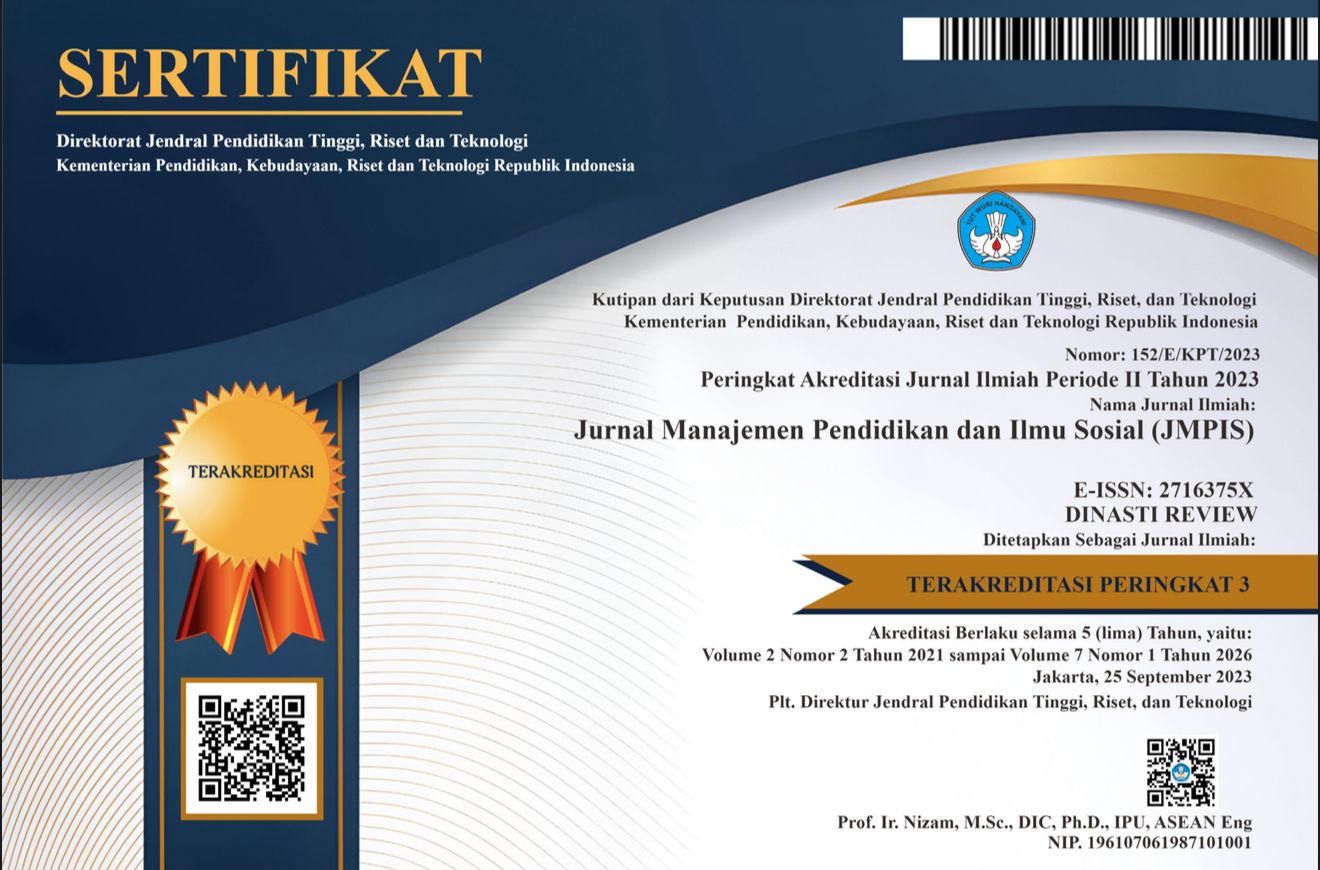DETERMINASI MINAT MENGUNJUNGI DAN EXPECTED VALUE: ANALISIS DIGITAL MARKETING DAN KEARIFAN LOKAL (LITERATURE REVIEW MANAJEMEN PEMASARAN)
DOI:
https://doi.org/10.38035/jmpis.v3i1.1095Keywords:
Expected Value, Minat Mengunjungi, Digital Marketing dan Kearifan LokalAbstract
Penelitian sebelumnya atau yang terkait sangat penting dalam sebuah penelitian atau disertasi akademik. Studi sebelumnya atau terkait dapat membantu memperkuat teori dan fenomena hubungan atau efek antar variabel. Artikel ini menjelaskan cara menentukan minat mengunjungi dan expected value seseorang untuk berkunjung. Menargetkan digital marketing dan kearifan lokal dengan objek yang dibidik adalah seluruh destinasi wisata di Kabupaten Solok, Sumatera Barat. Tujuan penulisan artikel ini adalah untuk membuat hipotesis tentang pengaruh antar variabel yang akan digunakan dalam penelitian selanjutnya. Hasil survei perpustakaan ini adalah sebagai berikut: 1) digital marketing berpengaruh terhadap expected value; 2) kearifan lokal berpengaruh terhadap minat mengunjungi; 3) digital marketing berpengaruh terhadap minat mengunjungi; 4) kearifan lokal berpengaruh terhadap minat mengunjungi; dan 5) expected value berpengaruh terhadap minat mengunjungi.
References
Adedeji, A. N., Sidique, S. F., Rahman, A. A., & Law, S. H. (2016). The role of local content policy in local value creation in Nigeria’s oil industry: A structural equation modeling (SEM) approach. Resources Policy, 49, 61–73. https://doi.org/10.1016/j.resourpol.2016.04.006
Affandy, S. (2019). Penanaman Nilai-Nilai Kearifan Lokal Dalam Meningkatkan Perilaku Keberagamaan Peserta Didik. Atthulab: Islamic Religion Teaching and Learning Journal, 2(2), 69–93. https://doi.org/10.15575/ath.v2i2.3391
Ali, H., Limakrisna, N., & Jamaluddin, S. (2016). Model of customer satisfaction: The empirical study at Bri in Jambi. International Journal of Applied Business and Economic Research.
Andina, S. A., & Aliyah, I. (2021). Faktor-Faktor Yang Mempengaruhi Minat Wisatawan Dalam Mengunjungi Wisata Budaya Candi Borobudur. Jurnal Cakra Wisata, 22(3), 27–38.
Anuvareepong, S. (2017). The assessment of hospitality and tourism SMEs awareness on the use of mobile technology and Internet services - A case study of hotel businesses in Thailand. Proceeding - 2016 2nd International Conference on Science in Information Technology, ICSITech 2016: Information Science for Green Society and Environment, pp. 350–355. https://doi.org/10.1109/ICSITech.2016.7852661
Arismayanti, N. K. (2017). Branding Strategy of Tourism in Bali Based on Cultures and Heritage. International Science, Social Science, Engineering and Energy Conference, (Table 1), 1–14.
Arismayanti, N. K. (2021). Community Local Wisdom and Efforts to Create Quality Marine Tourism. Webology, 18(2), 243–260. https://doi.org/10.14704/web/v18i2/web18319
Astuti, N. N. S. (2018). Designing Bali tourism model through the implementation of tri hita karana and sad kertih values. International Journal of Linguistics, Literature and Culture, 5(1), 12–23. https://doi.org/10.21744/ijllc.v5n1.461
Atasoy, O., & Morewedge, C. K. (2018). Digital goods are valued less than physical goods. Journal of Consumer Research, 44(6), 1343–1357. https://doi.org/10.1093/jcr/ucx102
Autier, P. (2018). Mammography screening: A major issue in medicine. European Journal of Cancer, 90, 34–62. https://doi.org/10.1016/j.ejca.2017.11.002
Azman, H. A., & Elsandra, Y. (2020). Analisis Faktor-Faktor yang Mempengaruhi Minat Kunjungan Berulang Wisatawan Milenial ke Bukittinggi. AMAR (Andalas Management Review), 4(1), 1–17. https://doi.org/10.25077/amar.4.1.1-17.2020
Bhuiyan, M. A. H., & Darda, M. A. (2020). Tourists’ satisfaction on heritage sites of Dhaka city in Bangladesh. International Journal of Culture, Tourism and Hospitality Research, 14(1), 34–43. https://doi.org/10.1108/IJCTHR-06-2018-0081
Buchanan, L., Kelly, B., Yeatman, H., & Kariippanon, K. (2018). The effects of digital marketing of unhealthy commodities on young people: A systematic review. Nutrients, 10(2), 1–19. https://doi.org/10.3390/nu10020148
Camilleri, M. A. (2018). The Planning and Development of the Tourism Product. In M. A. Camilleri (Ed.), Tourism Planning and Destination Marketing (pp. 1–23). https://doi.org/10.1108/978-1-78756-291-220181001
Coglianese, C. (2017). Regulating by robot: Administrative decision making in the Machine-learning era. Georgetown Law Journal, Vol. 105, pp. 1147–1223. Retrieved from https://www.scopus.com/inward/record.uri?partnerID=HzOxMe3b&scp=85025587354&origin=inward
Dressler, M., & Paunovic, I. (2019). Customer-centric offer design: Meeting expectations for a wine bar and shop and the relevance of hybrid offering components. International Journal of Wine Business Research, 31(1), 109–127. https://doi.org/10.1108/IJWBR-07-2018-0036
Eckhardt, G. M. (2019). Marketing in the Sharing Economy. Journal of Marketing, 83(5), 5–27. https://doi.org/10.1177/0022242919861929
Ernawati, S. (2021). TOURIST ATTRACTIONS AND SERVICESCAPE AS EFFORTS TO INCREASE VISITING INTEREST ON HALAL TOURISM IN BIMA CITY. 6(1), 20–30.
Eskandari, N., & Noorzai, E. (2021). Offering a preventive solution to defects in commercial building facility system using BIM. Facilities, ahead-of-p(ahead-of-print). https://doi.org/10.1108/F-04-2020-0037
Farmer, G. D., Warren, P. A., El-Deredy, W., & Howes, A. (2017). The Effect of Expected Value on Attraction Effect Preference Reversals. Journal of Behavioral Decision Making, 30(4), 785–793. https://doi.org/10.1002/bdm.2001
Fauzi, F., Suryanto, T., Anggraeni, E., & Nasor, M. (2020). the Effect of Tourism Image, Service Quality, and Promotion on Religious Tourism Interest in Pringsewu Regency. Jurnal Ekonomi Dan Bisnis Islam (Journal of Islamic Economics and Business), 6(1), 78. https://doi.org/10.20473/jebis.v6i1.18713
Finardi, A. D. I., & Yuniawati, Y. (2016). Gunung Tangkuban Perahu Pengaruh Customer Experience Terhadap Revisit Intention Di. Tourism and Hospitality Essentials (THE) Journal, 6(1), 983–994.
Fiona, F., Susetyo, S., Meilyandra, A., & Putri, P. (2022). Digital Marketing Through Social Media Instagram as a Promotion Means to Increase Interest in Visiting Bengkulu Tourism Objects. 647(Seabc 2021), 63–70.
Følstad, A. (2018). Customer journeys: a systematic literature review. Journal of Service Theory and Practice, Vol. 28, pp. 196–227. https://doi.org/10.1108/JSTP-11-2014-0261
Gan, C., & Wang, W. (2017). The influence of perceived value on purchase intention in social commerce context Internet Research Article information?: (June). https://doi.org/10.1108/IntR-06-2016-0164
Garai, T., Chakraborty, D., & Roy, T. K. (2017). Expected Value of Exponential Fuzzy Number and Its Application to Multi-item Deterministic Inventory Model for Deteriorating Items. Journal of Uncertainty Analysis and Applications, 5(1). https://doi.org/10.1186/s40467-017-0062-7
Georgescu Paquin, A., & Cerdan Schwitzguébel, A. (2021). Analysis of Barcelona’s tourist landscape as projected in tourism promotional videos. International Journal of Tourism Cities, 7(2), 257–277. https://doi.org/10.1108/IJTC-03-2020-0046
Gilang Widagdyo, K. (2015). Analisis Pasar Pariwisata Halal Indonesia. The Journal of Tauhidinomics, 1(1), 73–80.
Gürhan-Canli, Z. (2018). Consumers and Brands across the Globe: Research Synthesis and New Directions. Journal of Marketing, 26(1), 96–117. https://doi.org/10.1509/jim.17.0063
H. Demolinggo, R., Damanik, D., Wiweka, K., & Pramania Adnyana, P. (2020). Sustainable Tourist Villages Management Based on Javanese Local Wisdom ‘Memayu Hayuning Bawono’ Best Practice of Desa Wisata Pentingsari, Yogyakarta. International Journal of Tourism & Hospitality Reviews, 7(2), 41–53. https://doi.org/10.18510/ijthr.2020.725
Hakim, W. dan L. N. (2018). Manajemen Strategis dan Isu - Isu Kekinian. Jakarta: Mitra Media Wacana Media.
Hamzah, A. S., & Irfan, M. (2018). Local Wisdom Based Tourist Village Sade Lombok Organization within the Framework of Sustainable Tourism Development. 282(4000), 129–132. https://doi.org/10.2991/icblt-18.2018.31
Heath, A., Kunst, N., Jackson, C., Strong, M., Alarid-Escudero, F., Goldhaber-Fiebert, J. D., … Jalal, H. (2020). Calculating the Expected Value of Sample Information in Practice: Considerations from 3 Case Studies. Medical Decision Making, 40(3), 314–326. https://doi.org/10.1177/0272989X20912402
Hollebeek, L. (2019). Digital Content Marketing’s Role in Fostering Consumer Engagement, Trust, and Value: Framework, Fundamental Propositions, and Implications. Journal of Interactive Marketing, 45, 27–41. https://doi.org/10.1016/j.intmar.2018.07.003
Hudson, S. (2015). The effects of social media on emotions, brand relationship quality, and word of mouth: An empirical study of music festival attendees. Tourism Management, 47, 68–76. https://doi.org/10.1016/j.tourman.2014.09.001
Hwang, J. (2020). Food tourists’ connectivity through the 5A journey and advocacy: comparison between generations Y and X. Asia Pacific Journal of Tourism Research, 25(1), 27–38. https://doi.org/10.1080/10941665.2019.1580756
Kamuri, K. J., & Kurniawati, M. (2020). The Influence of Digital Marketing Tools on Tourist Visiting Interest to Fatukopa Hill, TTS Regency. 158(June), 392–396. https://doi.org/10.2991/aebmr.k.201212.055
Kanwel, S., Lingqiang, Z., Asif, M., Hwang, J., Hussain, A., & Jameel, A. (2019). The influence of destination image on tourist loyalty and intention to visit: Testing a multiple mediation approach. Sustainability (Switzerland), 11(22). https://doi.org/10.3390/su11226401
Kreiss, D. (2018). Technology Firms Shape Political Communication: The Work of Microsoft, Facebook, Twitter, and Google With Campaigns During the 2016 U.S. Presidential Cycle. Political Communication, 35(2), 155–177. https://doi.org/10.1080/10584609.2017.1364814
Kumar, V. (2016). Research framework, strategies, and applications of intelligent agent technologies (IATs) in marketing. Journal of the Academy of Marketing Science, 44(1), 24–45. https://doi.org/10.1007/s11747-015-0426-9
Lamberton, C. (2016). A thematic exploration of digital, social media, and mobile marketing: Research evolution from 2000 to 2015 and an agenda for future inquiry. Journal of Marketing, Vol. 80, pp. 146–172. https://doi.org/10.1509/jm.15.0415
Lauwers, L., & Vallentyne, P. (2016). The role of the expected value of individualized care in cost-effectiveness analyses and decision making. Economics and Philosophy, 32(3), 383–407. https://doi.org/10.1017/S0266267115000334
Lie, D., & Wijaya, A. (2017). Pengaruh Gaya Kepemimpinan Dan Etos Kerja Terhadap Kepuasan Kerja Karyawan Pada Pt Taspen (Persero) Kc Pematangsiantar. 3(2), 1–9.
Lita, R. P., Meuthia, M., Alfian, H., & Dewi, D. S. (2021). Perceived Packaging , Perceived Value , Perceived Quality dan Purchase Intention pada Tenun Kubang di Kabupaten Lima Puluh Kota Perceived Packaging , Perceived Value , Perceived Quality and Purchase Intention on Kubang Weaving in Lima Puluh Kota Regency. 12(28), 46–61. https://doi.org/10.33059/jseb.v12i1.2418
Lubis, H., Rohmatillah, N., & Rahmatina, D. (2020). Strategy of Tourism Village Development Based on Local Wisdom. Jurnal Ilmu Sosial Dan Humaniora, 9(2), 320. https://doi.org/10.23887/jish-undiksha.v9i2.22385
Lucyantoro, B., & Rachmansyah, M. (2018). Penerapan Strategi Digital Marketing, Teori Antrian Terhadap Tingkat Kepuasan Pelanggan (Studi Kasus di MyBCA Ciputra World Surabaya). Jurnal Ekonomika ’45, 5(1).
MacKey, T. (2016). Digital danger: A review of the global public health, patient safety and cybersecurity threats posed by illicit online pharmacies. British Medical Bulletin, Vol. 118, pp. 110–126. https://doi.org/10.1093/bmb/ldw016
Maestro, N. B., & Dumlao, M. F. (2019). Romblon islands into a smart tourism destination through point of interest recommender, augmented reality and near field communication: A proposal. International Journal of Innovative Technology and Exploring Engineering, 8(6 C2), 242–247. Retrieved from https://www.scopus.com/inward/record.uri?partnerID=HzOxMe3b&scp=85069872270&origin=inward
Manalu, M., & Mujiono, K. (2019). Pengaruh Pengetahuan Program Komunikasi City Branding World’s City of Batik Kota Pekalongan Terhadap Persepsi Citra Kota dan Minat Berkunjung Wisatawan. Interaksi Online, 7(1), 99–107. Retrieved from https://ejournal3.undip.ac.id/index.php/interaksi-online/article/view/22695
Mastika, I. K. (2018). Pengembangan Ekowisata Berwawasan Kearifan Lokal Di Wilayah Eks Karesidenan Besuki, Jawa Timur. Jurnal Master Pariwisata, 4, 240–252. https://doi.org/10.24843/JUMPA.2018.v04.i02.p06
Melero, I. (2016). Recasting the customer experience in today’s omni-channel environment. Universia Business Review, 2016(50), 18–37. https://doi.org/10.3232/UBR.2016.V13.N2.01
Mohamed, M. E., Hewedi, M., Lehto, X., & Maayouf, M. (2020). Marketing local food and cuisine culture online: a case study of DMO’s websites in Egypt. International Journal of Tourism Cities, 6(4), 1045–1068. https://doi.org/10.1108/IJTC-05-2019-0067
Mortazavi, R. (2021). The relationship between visitor satisfaction, expectation and spending in a sport event. European Research on Management and Business Economics, 27(1), 100132. https://doi.org/10.1016/j.iedeen.2020.10.002
Nientied, P. (2021). Rotterdam and the question of new urban tourism. International Journal of Tourism Cities, 7(2), 344–360. https://doi.org/10.1108/IJTC-03-2020-0033
Parastiwi, F. D., & Farida, N. (2018). Pengaruh Daya Tarik Dan Word-of-Mouth Terhadap Kunjungan Ulang Melalui Kepuasan. Jurnal Administrasi Bisnis, 6(2), 72. https://doi.org/10.14710/jab.v6i2.16608
Parise, S. (2016). Solving the crisis of immediacy: How digital technology can transform the customer experience. Business Horizons, 59(4), 411–420. https://doi.org/10.1016/j.bushor.2016.03.004
Perbawasari, S., Sjuchro, D. W., Setianti, Y., Nugraha, A. R., & Muda, I. (2019). Halal tourism communication formation model in west Java, Indonesia. Geojournal of Tourism and Geosites, 25(2), 309–320. https://doi.org/10.30892/gtg.25203-361
Petit, O. (2019). Digital Sensory Marketing: Integrating New Technologies Into Multisensory Online Experience. Journal of Interactive Marketing, 45, 42–61. https://doi.org/10.1016/j.intmar.2018.07.004
Piscicelli, L. (2018). What makes a sustainable business model successful? An empirical comparison of two peer-to-peer goods-sharing platforms. Journal of Cleaner Production, 172, 4580–4591. https://doi.org/10.1016/j.jclepro.2017.08.170
Prabowo, W. A. (2018). Pengaruh Digital Marketingterhadap Organizational Performance Denganintellectual Capital Dan Perceived Qualitysebagai Variabel Intervening Pada Industri Hotel Bintang Tiga Di Jawa Timur. Jurnal Manajemen Pemasaran, 12(2), 101–112. https://doi.org/10.9744/pemasaran.12.2.101-112
Pramono, T. (2019). Qualitative Factors that Influence Tourism Interests Visiting Tourism Destinations in Indonesia. Global Journal of Social Sciences Studies, 5(2), 156–167. https://doi.org/10.20448/807.5.2.156.167
Putriansyah, Y. N., Terapan, F. I., Telkom, U., Fakultas, D., Terapan, I., Telkom, U., & Bandung, N. (2020). Pengaruh Customer Relationship Management Terhadap Loyalitas Pelanggaan Koperasi Nusantara Bandung Tahun 2020 The Influence Of Customer Relationship Management On Loyalty Of Koperasi Nusantara Bandung Customers In 2020. 6(2), 1130–1136.
Redjeki, F., & Affandi, A. (2021). Utilization of Digital Marketing for MSME Players as Value Creation for Customers during the COVID-19 Pandemic. International Journal of Science and Society, 3(1), 40–55. Retrieved from http://ijsoc.goacademica.com/index.php/ijsoc/article/view/264
Riadhus Sholihin. (2019). Digital Marketing Di Era 4.0 (Pertama). Yogyakarta: Quadrant.
Rideng, I. W., Budiartha, I. N. P., & Sukandia, I. N. (2020). The development of bali tourism through cultural and local wisdom of customary village. International Journal of Entrepreneurship, 24(5), 1–6.
Robinson, T. N. (2017). Screen media exposure and obesity in children and adolescents. Pediatrics, 140. https://doi.org/10.1542/peds.2016-1758K
Safira, R. E., Noer, D., Rahmanto, A., Syams, A., & Fahmi, R. (2018). Regional Promotion And. 2(2).
Seni, D., & Tradisional, P. (2018). No Title. 7(2), 145–160.
Siregar, O. M., Selwendri, ., & Abdilah, M. B. (2020). Factors to Increase Tourist Loyalty in North Sumatera. 199–204. https://doi.org/10.5220/0010013901990204
Sondakh, P. M. N., & Tumbel, A. (2016). Ke Objek Wisata Alam Gunung Mahawu , Tomohon the Influence of Services , Sefety and Attractiveness To Attract Tourist Who Visited Mahawu Volcano Mountain in Tomohon City. Jurnal Berkala IImiah Efesiensi, 16(01), 280–288.
Srisusilawati, P. (2020). Factors Affecting Tourist Interest on Sharia Tourism. Al-Uqud?: Journal of Islamic Economics, 4(2), 200. https://doi.org/10.26740/al-uqud.v4n2.p200-207
Sudarmayasa, I. W., Setiyowati, E., Uhai, S., & Anugrah, K. (2022). The Effect of Location on the Marketing of Sustainable Community-Based Tourism Destinations in the Pela Tourism Village. 647, 723–728.
Sulistyan, R. B., Ariyono, K. Y., & Taufiq, M. (2018). Identifikasi Faktor-Faktor Kritis Dalam Minat. UNEJ E-Proceeding, 207–216.
Sumiati, D. (2017). Intercultural Communication Based on Local Wisdom That Made the People of Bali Reject Sharia Tourism. Asian Journal of Media and Communication (AJMC), 1(2), 137–146. Retrieved from https://journal.uii.ac.id/AJMC/article/view/9437/7741
Suryaningsih, I. B., & Sumani, S. (2019). the Influence of Financial Literacy, the Image of Destination, the Social Media Against the Interest of Visiting Local Tourists …. European Journal of Management and …, (2016), 1–18. https://doi.org/10.5281/zenodo.2542742
Thorn, J., Coast, J., & Andronis, L. (2016). Interpretation of the Expected Value of Perfect Information and Research Recommendations: A Systematic Review and Empirical Investigation. Medical Decision Making, 36(3), 285–295. https://doi.org/10.1177/0272989X15586552
Tjiptono, F. (2015). strategi pemasaran (4th ed.). andi.
Xue, Y., & Deng, Y. (2020). Refined expected value decision rules under orthopair fuzzy environment. Mathematics, 8(3). https://doi.org/10.3390/math8030442
Yanto, B. T. (2020). EXPERIENTIAL MARKETING AND EXPERIENTAL VALUE , HOW DOES IT IMPACT ON CONSUMER REPURCHASE INTENTIONS. 3(1), 34–42.
Yanuar M, M.?; dkk. (2017). Dampak kualitas produk, harga, promosi dan kualitas pelayanan terhadap kepuasan pelanggan optik marlin cabang jember. 3(1), 61–80.
Downloads
Published
How to Cite
Issue
Section
License
Hak cipta :
Penulis yang mempublikasikan manuskripnya di jurnal ini menyetujui ketentuan berikut:
- Hak cipta pada setiap artikel adalah milik penulis.
- Penulis mengakui bahwa Jurnal Manajemen Pendidikan dan Ilmu Sosial (JMPIS) berhak menjadi yang pertama menerbitkan dengan lisensi Creative Commons Attribution 4.0 International (Attribution 4.0 International CC BY 4.0) .
- Penulis dapat mengirimkan artikel secara terpisah, mengatur distribusi non-eksklusif manuskrip yang telah diterbitkan dalam jurnal ini ke versi lain (misalnya, dikirim ke repositori institusi penulis, publikasi ke dalam buku, dll.), dengan mengakui bahwa manuskrip telah diterbitkan pertama kali di Jurnal Manajemen Pendidikan dan Ilmu Sosial (JMPIS).











































































